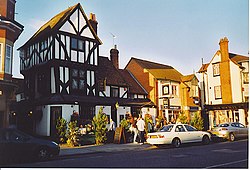Thame: Difference between revisions
Created page with '{{infobox town |name=Thame |county=Oxfordshire |picture=The Bird Cage Inn, Thame. - geograph.org.uk - 138013.jpg |picture caption=The Bird Cage Inn, Thame |latitude= 51.75 |longi…' |
mNo edit summary |
||
| Line 15: | Line 15: | ||
|website= [http://www.thametowncouncil.gov.uk/ Thame Town Council] | |website= [http://www.thametowncouncil.gov.uk/ Thame Town Council] | ||
}} | }} | ||
'''Thame''' is a town in Oxfordshire east of [[Oxford]] and some 7 miles southwest of [[Aylesbury]]. | '''Thame''' is a town in Oxfordshire east of [[Oxford]] and some 7 miles southwest of [[Aylesbury]]. | ||
Revision as of 18:25, 18 November 2010
| Thame | |
| Oxfordshire | |
|---|---|
 The Bird Cage Inn, Thame | |
| Location | |
| Grid reference: | SP710060 |
| Location: | 51°45’0"N, -0°58’12"W |
| Data | |
| Population: | 11,072 |
| Post town: | Thame |
| Postcode: | OX9 |
| Dialling code: | 01844 |
| Local Government | |
| Council: | South Oxfordshire |
| Parliamentary constituency: |
Henley |
| Website: | Thame Town Council |
Thame is a town in Oxfordshire east of Oxford and some 7 miles southwest of Aylesbury.
The town's name is pronounced Tame, with a silenet "h". The name comes from the River Thame which flows past the north side of the town.
Thame's broad high street contains numerous shops.
In July, Thame stages the Oxfordshire County and Thame Show, the largest one-day agricultural show in Britain.[1]. Every third Thursday in September, Thame Fair opens in the town centre. In October a smaller fair is held in the parking area in Upper High Street. In June, the Thame Festival is held, which includes a carnival through the main streets, a flower festival and a fete on the Southern Road recreation area.
History up to 1800
Thame Abbey was founded in 1138 for the Cistercian Order: the abbey church was consecrated in 1145. After the Dissolution of the Monasteries the church was demolished and Thame Park (the house) was built on the site, incorporating parts of the abbey including the early 16th century abbot's house. Its interior is one of the earliest examples of the Italian Renaissance in England. A Georgian west wing was added in the 18th century. In about 1840 parts of the foundations of the abbey church were excavated: it was 230 feet long and 70 feet wide, with a Lady Chapel extending a further 45 feet at the east end.[2]

The parish church of St Mary the Virgin was built in about 1220 in the Early English Gothic style but was later altered in the Decorated Gothic and Perpendicular Gothic styles.[3] The tower has a ring of eight bells, all of which were cast in 1876.[4]
The Prebendal House is known to have existed by 1234, and its Early English style chapel was built in about 1250. The solar was also built in the 13th century, and both buildings survive today. The rest of the Prebendal House dates from the 14th and 15th centuries.[5]
In 1550 the courtier John Williams, 1st Baron Williams of Thame built the almshouses in Church Lane. He died in 1559, and his will established the Grammar School. Its original building, completed in 1569, is next to the almshouses. In 1880 the school moved to its current premises in Oxford Road. In 1971 it became a comprehensive school under the name Lord Williams's School.
During the English Civil War in the 1640s Thame changed hands between the Royalists and Parliamentarians. After the Battle of Chalgrove Field the famed John Hampden, who had been educated at the Grammar School, died of his wounds at the house of Ezekiel Browne[6], later to become the Greyhound Inn. Some of Hampden's descendants still live in the town.
In the 18th century many of the buildings in the boat-shaped High Street were re-faced with modern facades built of locally produced salt glazed bricks. Late in the 18th century John Wesley preached in Thame. The congregation on that occasion was so large that the floor of the building gave way, and the crowd fell to the lower floor.[7]
References
- ↑ "Thame Show". http://www.thameshow.co.uk/.
- ↑ Sherwood & Pevsner, 1974, pp. 809, 810
- ↑ Sherwood & Pevsner, 1974, pp. 806-808
- ↑ Oxford Diocesan Guild of Church Bell Ringers, South Oxon branch. "St. Mary the Virgin, Thame". http://southoxonodg.co.uk/html/thame_.html.
- ↑ Sherwood & Pevsner, 1974, pp. 812-814
- ↑ Nugent & Nugent. Some memorials of John Hampden: his party and his times, (London: Chapman Hall, 1854, pg 361. http://books.google.com/books?id=B2ILAAAAYAAJ&dq=John%20Hampden%20Thame&lr&pg=PA361#v=onepage.
- ↑ Thame.Net. "A History of Thame". http://www.thame.net/history.htm.
Outside links
- Thame.net
- Thame Local History
- Thame Local News
- Visit Thame
- [url=http://www.thame.net/history.asp Historical Information about Thame]